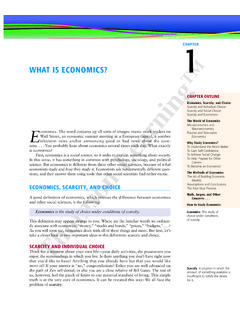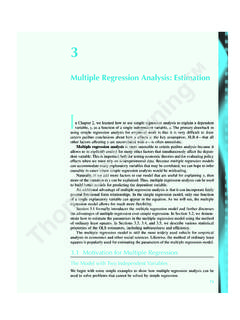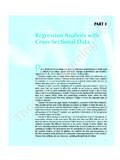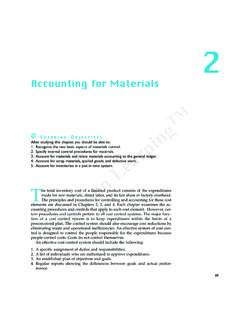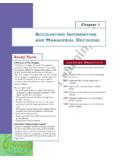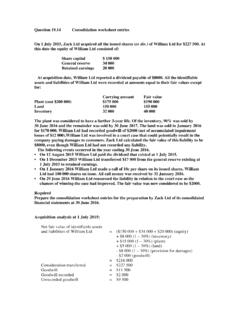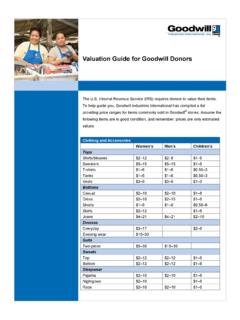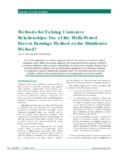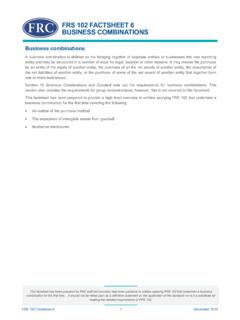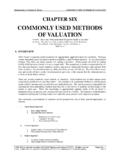Transcription of RECOGNIZING A MINORITY INTEREST IN CONSOLIDATED …
1 RECOGNIZING A MINORITY INTERESTIN CONSOLIDATED FINANCIAL STATEMENTSLEARNING OBJECTIVEA dapt the consolidation work sheet procedure to recognize a MINORITY 11 illustrates the consolidation procedure when the parent owns 100 percent of a subsidiary. Parentcompanies may, however, own less than 100 percent for several parent can gain control of a subsidiary with a smaller capital investment and therefore put less cap-ital at risk to loss. Parent companies generally gain control of a subsidiary when the ownership percent-age exceeds 50 percent.
2 A 51 percent investment in a subsidiary requires less capital than a 100 shareholders of the subsidiary may be unwilling to sell their shares, so the parent cannot acquire100 MINORITY INTEREST exists whenever a parent company owns a controlling INTEREST in a subsidiary butdoes not own 100 percent. The remaining shareholders in the subsidiary constitute the MINORITY INTEREST . Theseminority shareholders have a claim on the earnings and net assets of the subsidiary. The CONSOLIDATED bal-ance sheet includes all of the assets and liabilities of a subsidiary, not just an amount equal to the parent sownership percentage.
3 Likewise, the CONSOLIDATED income statement includes all of the revenues and expensesof a subsidiary, not just an amount equal to the parent s ownership percentage. The parent s controllinginterest permits it to manage all of the net assets of a subsidiary, justifying the inclusion of 100 percent ofthe subsidiary s assets, liabilities, revenues, and expenses in the CONSOLIDATED financial statements. The parentcompany does not, however, have a claim on 100 percent of the net assets or earnings. The consolidatedfinancial statements must therefore recognize the claim of the MINORITY shareholders.
4 We illustrate belowthe procedures to prepare a consolidation work sheet when a MINORITY INTEREST OF MINORITY INTEREST AT THE DATE OF ACQUISITIONR efer to the data in Chapter 11 for Company P and Company S in Appendix Recall that Company Pacquired 100 percent of the outstanding shares of Company S for $650,000 on January 1, Year 1. At thetime of acquisition, the book value of the shareholders equity of Company S was $650,000, comprising thefollowing account balances:COMPANY S, JANUARY 1, YEAR 1 Common Stock.
5 $500,000 Retained Earnings .. 150,000 Total Shareholders Equity ..$650,000 Assume now that Company P acquired only 80 percent of the outstanding common stock of Company Sand paid $520,000. Exhibit 1 shows the claims of Company P and of the MINORITY shareholders on the netassets of Company S on the date of worksheet entry to eliminate the Investment in Company S account, which appears on the books ofCompany P, is as follows: Common Stock (Company S) ..400,000 Retained Earnings (Company S) ..120,000 Investment in Company S (Company P).
6 520,000 The work sheet entry to recognize the MINORITY INTEREST claim on the net assets of Company S is as follows:Common Stock (Company S) ..100,000 Retained Earnings (Company S) ..30,000 MINORITY INTEREST in Net Assets of Company S( CONSOLIDATED Balance Sheet) ..130,000 The account MINORITY INTEREST in Net Assets of Company S does not appear on the books of either , the work sheet entry above creates this account. The CONSOLIDATED balance sheet includes all of theassets and liabilities of Company P (except the Investment in Company S account eliminated in the first entryabove) and of Company S.
7 The 20 percent claim of the MINORITY shareholders against the net assets ofCompany Sof $130,000 typically appears between liabilities and shareholders equity on the CONSOLIDATED bal-ance Note. A conceptual issue arises regarding the valuation of the MINORITY INTEREST in the netassets of a subsidiary when the parent paid more than the book value of the subsidiary s net assets on thedate of the MINORITY INTEREST reflect the book values on the subsidiary s books, the MINORITY INTEREST reflect the market values of the subsidiary s net assets implied by the pricepaid by the parent for its INTEREST in the subsidiary?
8 To understand this issue, assume in the example above that Company P had paid $560,000 instead of$520,000 for its 80 percent INTEREST in Company S. Using the book values of Company S s net assets yieldsa MINORITY INTEREST of $130,000 [= .20 ($500,000 + $150,000)]. The implied market value of the net assetsof Company S is $700,000 (= $560,000/.8). Using the market values of Company S s net assets yields aminority INTEREST of $140,000 (= .2 $700,000). Proponents of using book values of the subsidiary s net assets view CONSOLIDATED financial statements fromthe parent s viewpoint.
9 The parent paid $40,000 more than book value for its 80 percent INTEREST . The minor-ity shareholders did not pay an additional $10,000 for their INTEREST in the undervalued assets. The minorityinterest should therefore equal $130,000. Proponents of using market values of the subsidiary s net assetsview CONSOLIDATED financial statements from both the parent s and the MINORITY INTEREST s viewpoint. The netassets of Company S have a market value exceeding their book value of $50,000 (= $700,000 $650,000).If Company S were to sell its net assets for their market value, the MINORITY shareholders would have aclaim on 20 percent of the proceeds, or $140,000 (=.)
10 2 $700,000). RECOGNIZING a MINORITY INTEREST in CONSOLIDATED Financial Statements2 EXHIBIT 1 Allocation of Shareholders Equity of Company Sto Company P and the MINORITY Shareholderson the date of acquisitionTo MinorityTo Company PShareholdersTotal(80 percent)(20 percent)(1)(2)(3)Common Stock ..$500,000$400,000$100,000 Retained Earnings ..150,000120,00030,000 Total Shareholders Equity ..$650,000$520,000$130,000 Generally accepted accounting principles (GAAP) currently follow the first approach. Thus, in the exam-ple above, the consolidation work sheet shows a write-up of Company S s net assets, the recognition ofgoodwill, or both, for the $40,000 excess price paid by P Company.
